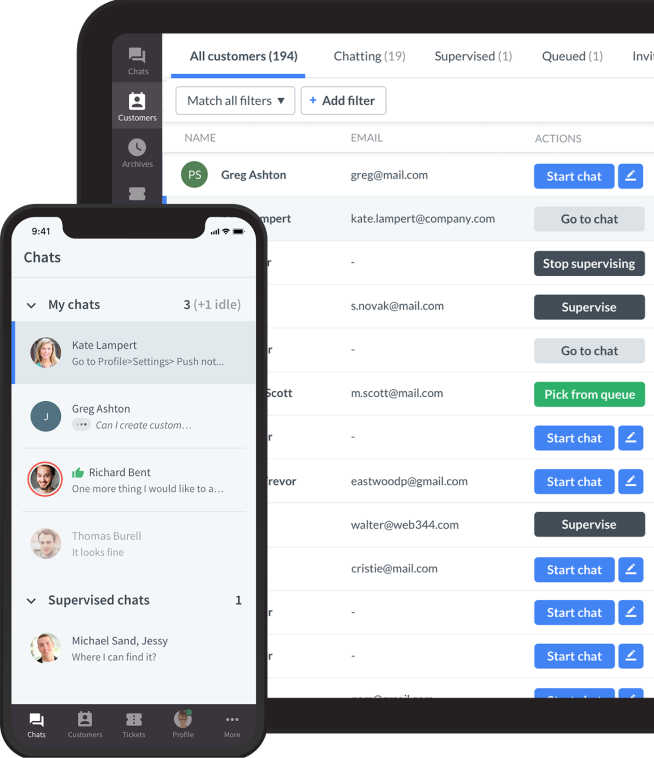
Ever browsed a website, found something interesting, but had one tiny question before buying, only to realize there’s no one around to help? You wait. You click around. Eventually, you give up.
That’s exactly the kind of lost opportunity live chat is built to prevent.
Live chat isn’t just a support tool anymore. It’s a real-time, friendly bridge between your business and your customers, the kind that helps you answer questions the moment they’re asked, clear up doubts while a shopper’s still deciding, and guide people toward the right purchase without ever feeling pushy.
And the results speak for themselves: up to 40% more conversions, 60% higher average order value, and 78% of customers buying from the first business that replies. That’s the power of being available when it matters most.
But here’s the thing: just adding a chat box to your site isn’t enough. To make live chat truly work for online sales, you need the right strategies. That means knowing when to reach out, how to start the conversation, and how to keep things personal, even if you're chatting with hundreds of people a day.
In this guide, I’ll walk you through the most effective live chat tips to help you close more deals, engage more meaningfully, and turn your website into a conversion machine, one conversation at a time.
1. Live chat tips for sales
When used strategically, live chat can transform your website into a live sales floor, where conversations replace click paths and objections get resolved in real time.
Below are the most impactful live chat sales techniques that help convert browsers into buyers, increase average order values, and reduce cart abandonment, while building long-term customer trust.
Start with proactive engagement
Most website visitors won’t start a conversation on their own. In fact, many shoppers abandon their carts simply because they’re unsure about a return policy, shipping costs, or product compatibility, but they don’t ask. This is where proactive live chat becomes your secret weapon.
By setting up behavior-based triggers, you can automatically start conversations at key moments. For example:
- Trigger: Visitor spends 90+ seconds on the pricing pageMessage: “Hi there! Have any questions about the features or pricing plans?”
- Trigger: Visitor adds item to cart and idles on checkoutMessage: “Need help completing your order? I'm happy to assist with shipping or payment options!”
This proactive approach significantly reduces friction in the buyer’s journey. According to industry data, businesses that use proactive chat have seen up to 305% ROI by simply being available at the right moment. It’s about anticipating needs, not just reacting to them.
Platforms like LiveChat allow you to set up custom triggers based on time spent, visited pages, or cart behavior, so you can meet customers exactly where they are.
Respond lightning fast with live chat messages
In online sales, speed is non-negotiable. A few seconds can be the difference between a conversion and a bounce. This means if your competitor replies even 10 seconds faster, they could walk away with the sale.
To stay ahead:
- Use chat routing to distribute incoming conversations based on agent availability or expertise.
- Set up canned responses for frequently asked questions so chat agents can reply instantly without sacrificing quality.
- Implement chatbots for triage, answering basic queries, and routing complex ones to the right rep quickly.
For example, if a visitor asks about delivery timelines, a bot can reply instantly with location-based shipping info, while alerting a human agent to follow up with personalized help if needed.
Tools like automated routing and agent availability trackingensure that no lead sits in the queue for too long, especially when timing can make or break the sale.
Use real-time lead qualification to prioritize conversations
Not every visitor is a buyer, but some are just a few questions away from becoming one. Live chat offers a perfect opportunity to qualify leads on the fly, helping sales reps focus on high-potential opportunities.
This doesn’t mean interrogating users. Instead, ask conversational questions that reveal buyer intent, such as:
- “Are you shopping for yourself or a team?”
- “What are you hoping this product will help you accomplish?”
- “When are you planning to make a decision?”
These questions help customer service agents gauge how close the visitor is to purchasing and adjust the conversation accordingly. For instance, someone buying for a large team may benefit from a demo or custom pricing. A casual browser may just need a gentle nudge, like a promo code.
When live chat is integrated with your CRM, like Salesforce, HubSpot, or Pipedrive, these qualified leads can be automatically tagged, scored, and sent to the sales team for follow-up, reducing the chance of losing them after the chat ends.

Personalize your pitch with behavioral context
One of the biggest advantages of live chat over traditional sales methods is real-time context. You’re not cold-calling or emailing someone randomly; you’re speaking to a visitor who’s actively browsing your site. Use that information to personalize the experience.
Most live chat platforms let you view:
- Which pages the visitor has viewed
- Whether they’re a returning user
- What items are in their cart
- Their device type, location, or referral source
Instead of saying, “How can I help you?”, try:
“Hi John! I see you’ve been checking out the Pro Plan. Would you like a quick comparison with our Basic Plan to help you decide?”
This kind of contextual messaging shows attentiveness and creates a sense of personalized service, even if the agent is juggling multiple chat windows. When done well, it makes website visitors feel like you get them, which builds trust and accelerates conversions.
LiveChat enhances this by showing live visitor tracking and previous chat history, so agents can always pick up where the customer left off.
Offer time-sensitive incentives during the chat
Sometimes, all a potential customer needs is a small push to complete their purchase. Live chat creates the perfect window to offer exclusive, time-sensitive incentives, right when the customer is most engaged.
These could include:
- A one-time discount code
- Free shipping on orders placed during the chat
- A bonus product or extended trial period
- Priority support or onboarding for premium purchases
Example:
“Thanks for chatting with us today! As a thank-you, I’d love to offer you 15% off if you complete your order during this session.”
It’s important not to overuse this tactic, but when used strategically, it creates a sense of urgency and appreciation, two emotions that drive buying decisions.
In LiveChat, you can even pre-load these incentives as quick replies or use integrations with coupon platforms to generate codes automatically during the conversation.
Analyze chat transcripts to refine your sales approach
Every chat holds a wealth of insight. Reviewing live chat transcripts helps you identify what’s working, what’s not, and where potential customers are getting stuck in their journey.
Look for:
- Common objections (e.g., pricing confusion, feature doubts)
- Repetitive questions (indicating unclear site content)
- High-converting phrases or tone used by top-performing agents
If multiple users ask, “Does this come with a warranty?”, that’s a sign your product page needs clarity. Or, if certain agents consistently convert more chats into sales, review their phrasing and use it to train others.
Regular transcript reviews also help refine your live chat playbooks, support knowledge base, and even inform marketing content. With reporting and transcript search tools, this becomes a quick, actionable process.
2. Customer engagement through live chat software
Engagement is everything. Website visitors now want meaningful, personal experiences that help them feel confident in their decisions. That’s where live chat shines.
Below, I examine how to use live chat not as a simple support tool, but as a high-impact engagement engine.
Deliver instant answers when they matter most
Speed is the single greatest advantage of live chat. While email might take hours, or even days, to get a response, live chat provides help right when a customer needs it most. In fact, 79% of customers prefer live chat for precisely this reason: they get their questions answered without delay, which keeps their buying momentum going.
Imagine a potential customer browsing a pair of wireless earbuds. She’s interested but unsure about compatibility with her phone. Without live chat, she might click away to look elsewhere or put off the purchase entirely. But with chat available, she asks her question and gets a quick response like:
“Yes, those earbuds are fully compatible with your phone, and they support Bluetooth 5.2 for better range.”
That one sentence might be the difference between a sale and an abandoned session. Being available with fast, relevant answers at decision-making moments removes friction and builds buyer confidence.
To maintain this level of responsiveness, many businesses use a mix of live agents, canned replies for FAQs, and chatbots that step in when volume spikes. The result is not just faster answers, but better experiences.
Create emotionally intelligent, human-centered experiences
A great chat conversation goes beyond providing information; it makes the customer feel understood.
Live chat software offers the rare opportunity to blend automation with humanity in a way that creates a real emotional connection.
Let’s say a shopper is hesitating before signing up for a business software subscription. They might ask, “Is the Standard Plan enough for a team of five?” Instead of offering a dry feature comparison, a skilled agent might respond:
“Great question, many of our small business customers start with the Standard Plan and upgrade as their team grows. I’d be happy to walk you through the features that matter most for teams your size.”
That kind of reply builds trust. It reassures the customer that they’re not just being sold to, they’re being guided by someone who understands their situation.
The emotional tone of a chat matters more than many businesses realize. Website visitors pick up on whether a conversation feels scripted or genuine. When agents respond with warmth, clarity, and empathy, customers are far more likely to stick around, spend more, and return in the future.
Live chat enables personalization at scale because you already have context, such as the visitor’s location, browsing history, or past chats. This means your team can tailor messages, use names, recall preferences, and carry the conversation forward with confidence.
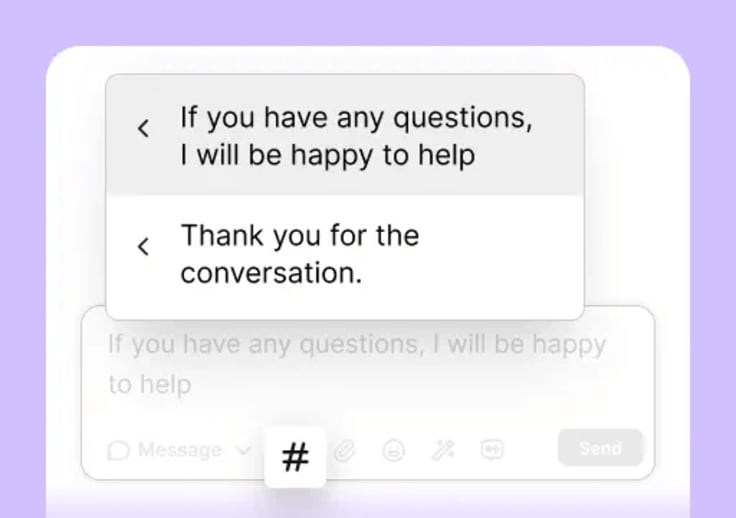
Respect privacy while collecting valuable insights
While customers want a personalized experience, they also want control over their data. That’s why it’s important to engage thoughtfully when asking for personal information. Interestingly, 42% of customers feel more comfortable sharing personal details over live chat than through forms or email. Why? Because it feels conversational, less formal, and more transparent.
During a live chat, when a potential customer is already engaged and receiving value, they’re more likely to share an email address or describe their use case, especially if it’s tied to a helpful offer. For example:
“I can send you a PDF guide with product comparisons based on your needs. Want me to email it over?”
When done respectfully, this not only improves the experience, but it turns a visitor into a qualified lead. The key is to make sharing feel like part of a helpful dialogue, not a transaction.
Live chat tools with CRM integration, like LiveChat, make this seamless. Data captured during chat can be synced instantly, enriching customer profiles without interrupting the conversation.
Combine automation with personalization
As chat volumes grow, businesses face a challenge: how do you stay personal without stretching your team too thin? The answer is smart automation, done right.
Chatbots are a valuable part of the live chat experience, especially when they handle repetitive questions, route inquiries, or collect basic information upfront. But bots shouldn’t replace humans, they should support them. A well-designed handoff from bot to human can feel just as natural as an in-store conversation.
For instance, a visitor lands on your homepage and engages with a chatbot that asks a few quick questions. After learning that the customer is looking for a software tool under $100/month for a small online sales team, the chatbot passes the conversation to a live agent. The agent then continues with:
“Thanks for the info! Based on your budget and team size, I recommend our Starter or Growth Plan. Would you like to see a comparison or get a discount code to test it out?”
This seamless transition keeps the conversation flowing and makes the visitor feel like they’re receiving tailored advice rather than generic suggestions.
Tools like LiveChat let you create automated workflows that trigger based on visitor behavior. Then, with full context, you hand off to a real agent. That means faster service without sacrificing the personal touch.
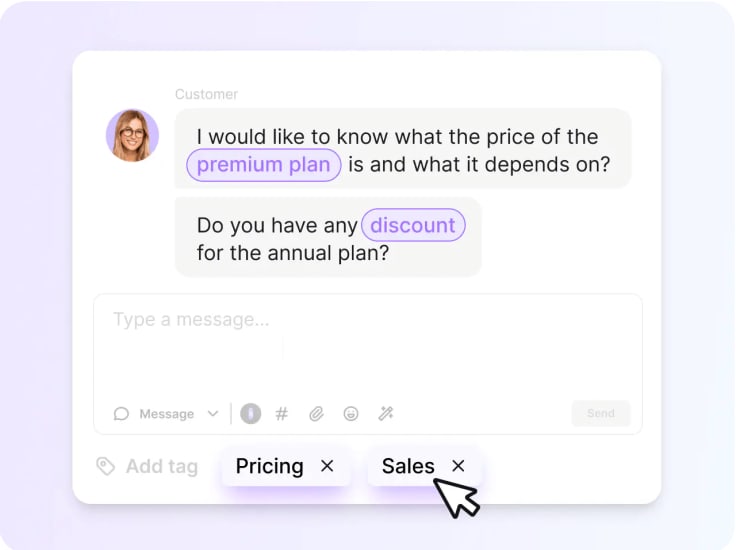
3. Improving customer service with live chat
Live chat offers something that phone support and email can’t: instant, effortless, real-time assistance that meets customers where they are. When you blend fast, personalized support with thoughtful service design, live chat becomes the channel that drives customer satisfaction and long-term retention.
Here’s how to leverage live chat to elevate your customer service experience, without sacrificing empathy or efficiency.
Offer convenience that customers actually love
Customers don’t want to dig through knowledge bases or sit on hold; they want help now. And they want it to be easy. That’s exactly what makes live chat software so powerful: it’s available in the moment, right on the page where frustration or uncertainty might arise.
Instead of forcing users to leave the site to get support, live chat keeps the experience seamless and fluid. A shopper might be on the checkout page and suddenly wonder, “Can I use two promo codes?” If there's no easy way to get the answer, they might bounce. But if there’s a chat bubble right there and someone responds instantly with:
“You can use one promo code per order, but I can help you apply the one with the best value.”
That’s convenience at its best. You’ve solved a problem before it became a lost sale.
This type of support doesn’t just reduce abandonment, it boosts customer satisfaction. It shows that you're present and ready to help, which makes customers feel confident in your brand.
Even better, with tools like LiveChat, you can offer asynchronous support, which means website visitors can leave the conversation and come back later without losing their chat history. It's support on their terms, which builds even more trust.
Resolve problems faster, with a better experience
Speed is critical in customer service, not just for delighting customers, but for saving your team time. With live chat, issues that once took hours via email or required long calls can be resolved in minutes.
Let’s take a common support example: a customer received the wrong item in their order. If they had to email support, it might take 24–48 hours just to get a response. On the phone, they might face long wait times and need to repeat information to different agents.
But with live chat, that same customer can message your sales team, upload a photo of the incorrect item, and receive an apology and resolution in real time:
“Thanks for sharing that imagw. I can see the mistake. We’ll ship the correct item today, and you can keep the one you received.”
It’s fast, it’s friendly, and it resolves the issue on the spot. No stress, no waiting.
This efficiency doesn’t just solve problems; it leaves a lasting impression. Studies show that live chat has the highest customer satisfaction rate of any support channel because it combines speed with the feeling of being personally taken care of.
Because transcripts are stored, agents can always refer back to past conversations, so customers never have to repeat themselves. This detail may seem small, but it makes a big impact.
Scale support without losing the human touch
As your business grows, support volume will inevitably increase. The challenge is scaling your service without losing the personal, helpful feel that made your early customers loyal in the first place.
That’s where chatbots and automation come in, but only if they’re implemented with care.
For basic tasks like order tracking, returns, or product availability, bots can provide fast answers 24/7. But when the issue is more complex, like account concerns, subscription changes, or delivery problems, your live agents can take over.
This blended model helps you:
- Provide round-the-clock coverage
- Speed up resolution for common questions
- Free up agents to focus on high-value conversations
The best part? When the handoff is smooth, customers rarely notice. With LiveChat’s intelligent automation, bots can collect details first, such as order number, issue category, and preferences, and then seamlessly pass everything to a human agent so the conversation picks up without repetition.
By combining automation with empathy, you can deliver consistent, high-quality service at scale, without burning out your sales team or frustrating your customers.
4. Integrate live chat into your CRM and sales tools
Live chat delivers the most value when it’s not just a support tool, but an integrated part of your entire sales and customer relationship strategy.
When connected to your CRM and sales platforms, live chat software becomes a dynamic, data-powered channel that drives conversions, shortens the online sales process, and creates loyal customers.
Seamless CRM integration for end-to-end visibility
Syncing your live chat with your CRM ensures that every conversation becomes a documented part of your customer's journey. This integration allows sales reps to instantly access user profiles, purchase history, previous live chat interactions, and account status during a chat session.
No more switching between tabs or scrambling for context. Agents are equipped with everything they need to offer highly relevant responses in real time.
It also ensures that post-chat follow-ups, whether for renewals, upsells, or support, are timely and informed. Sales teams can prioritize leads based on interaction history, assign follow-up tasks automatically, and track performance across the entire funnel.

Use behavioral triggers to start live chat conversations that convert
Instead of waiting for users to reach out, proactive chat initiation based on real-time behavior increases engagement and conversions. Set up behavioral triggers that launch a chat when a user scrolls to a specific section, lingers on a high-intent page (like pricing or checkout), or adds items to their cart without completing the purchase.
These triggers enable your team to catch potential buyers at the precise moment they might need reassurance, additional information, or a nudge toward checkout. This kind of intelligent timing can turn passive browsers into qualified leads or even immediate buyers.

Personalize live chat using CRM and ecommerce data
Generic greetings don’t cut it anymore. Customers expect personalization, and your tools can deliver it. When your live chat software pulls data from your CRM or ecommerce system, agents can address returning users by name, acknowledge previous purchases, or tailor suggestions based on browsing behavior.
For instance, an agent could say: “Hi Jessica, I saw you recently bought our Starter Pack. If you’re looking to upgrade, I’d be happy to walk you through the Pro version features.” This level of personalization builds trust, improves satisfaction, and dramatically increases conversion rates.
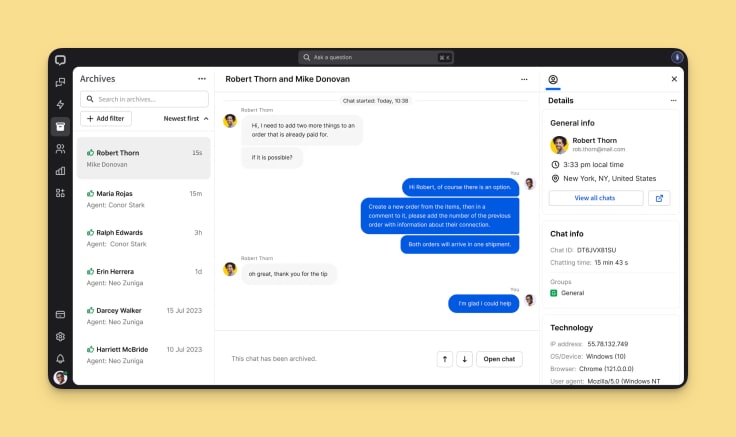
Capture leads with low-friction, real-time forms
Live chat offers a frictionless environment for lead capture, especially when prospects are already engaged on your site. According to recent studies, 42% of users are willing to share their contact details in a live chat if it helps them get faster answers or more relevant assistance.
You can make the most of this by embedding lead capture forms directly into your chat interface or prompting users to share details during conversations. Whether it’s collecting an email address before a product demo or asking qualifying questions during a support chat, this method feels more natural and less invasive than traditional forms.

Enhance your entire sales process
From prospecting to closing and post-sale engagement, integrated live chat touches every phase of your sales funnel. It helps qualify leads in real-time, supports mid-funnel education, and enables account managers to maintain relationships with existing clients through quick, contextual touchpoints.
Combined with CRM automation, live chat data can trigger workflows, schedule reminders, and feed analytics dashboards that drive smarter decisions.

5. Live chat implementation best practices
Live chat is a powerful tool, but its success depends on how thoughtfully it’s implemented. A strategically placed live chat widget, backed by well-trained agents and intelligent automation, can significantly boost sales, reduce friction, and increase conversions.
Here’s how to ensure your live chat software delivers maximum impact from day one.
Place chat strategically across high-intent touchpoints
Not every page on your website warrants live chat access, but some absolutely do. Focus on embedding your live chat widget where potential customer intent is highest: product pages, pricing pages, and the checkout flow. These are the moments when users are evaluating your offering, comparing features, or hesitating before completing a purchase.
A well-timed, friendly chat invitation, perhaps offering product guidance or a discount, can provide the reassurance they need to move forward. Additionally, consider including live chat support on onboarding pages, account dashboards, or knowledge base sections, where users may require extra assistance.
Automate outside working hours to stay responsive 24/7
While live agents can’t be available around the clock, your chat function shouldn’t disappear when your customer support team is offline. Implement chatbots to handle incoming messages during off-hours. These bots can greet users, answer common FAQs, guide them to helpful resources, or collect contact details for follow-up.
The goal is to ensure every visitor feels acknowledged, even if they’re browsing at 2 AM. With the right chatbot setup, you can generate leads overnight, reduce support load during peak hours, and maintain a consistent brand experience at all times.
Track the right metrics to boost customer satisfaction
Just launching live chat software isn’t enough; you need to monitor key metricsthat reflect both efficiency and effectiveness. Response time is critical; users expect a reply within seconds, not minutes. Resolution rate tells you how often chat interactions are solving problems without needing further follow-up.
Also, keep an eye on chat-to-sale conversion: how many conversations turn into purchases or lead captures? These KPIs help you identify what’s working, where live chat agents may need more support, and how chat contributes to your broader business goals.
Train your team for conversational excellence
Your live chat agents are the voice of your brand; make sure they sound the part. Provide onboarding and continuous training that covers more than just product knowledge. Agents should have access to clear, adaptable scripts for common scenarios, personalization techniques to tailor responses, and language guidelines that reflect your brand’s tone, whether that’s friendly and casual or professional and concise.
Encourage active listening, empathy, and clarity in every interaction. A well-trained team can handle more chats effectively and turn potential customer conversations into brand-building moments.
How LiveChat helps you stand out
There’s no shortage of live chat tools out there, but not all of them are built with sales performance, customer engagement, and long-term relationship building in mind.
What makes LiveChat stand out is how its features align directly with the techniques and strategies we’ve covered throughout this article. Whether you’re trying to close more deals, respond faster, or create personalized customer experiences that scale, LiveChat equips your team with the right tools at every step.
Here’s how it supports your live chat goals, not just with features, but with results.
Smart triggers and routing: engage the right person at the right moment
You’ve learned how proactive engagement is essential to converting hesitant website visitors. LiveChat makes this effortless with smart chat triggers that let you automatically initiate conversations based on behavior, such as time on page, cart value, or returning visits.
For example, you can trigger a message like:
“Need help deciding between plans? I’m happy to help!”
When a user lingers on your pricing page. Combine that with chat routing rules, and the visitor is instantly connected to the most relevant sales agent, reducing wait time and boosting conversion potential. Faster response = first-mover advantage. And LiveChat gives you both.

Crm integrations: turn conversations into qualified leads
You want to personalize interactions and follow up effectively, and that starts with having customer data in the right place. LiveChat integrates seamlessly with top CRMs like HubSpot, Salesforce, Pipedrive, and dozens more, ensuring that lead data collected in real-time chat flows directly into your sales pipeline.
This means agents don’t just have access to chat history; they can see the customer’s purchase history, previous inquiries, tags, and segmentation in one place. It empowers your team to tailor every conversation and prioritize high-quality leads based on actual behavior, not guesswork.
It’s not just follow-up, it’s intelligent follow-through.

Rich chat features: close deals inside the conversation
Sales-focused live chat isn’t just about answering questions; it’s about giving website visitors the tools and information they need to act now. With LiveChat, your team can do more than chat. They can:
- Share product cards directly in the conversation with pricing and images
- Set up chatbot handoffs that collect info before routing to an agent
- Schedule follow-up chats or demos without switching platforms
It’s a complete sales assistant in one window, making it easy to move from question to purchase without interrupting the customer’s flow. That smooth experience keeps bounce rates low and conversion rates high.

Reporting and insights: optimize what’s working, fix what’s not
The best online sales teams are the ones that learn and adapt. LiveChat gives you the ability to do just that with built-in analytics dashboards that track the metrics that matter:
- Agent response time
- Chat-to-conversion rates
- Customer satisfaction (CSAT) scores
- Missed opportunities and chat volume trends
These insights allow managers to coach their teams, tweak automated workflows, and identify high-performing tactics based on actual results, not just gut feeling. For businesses looking to continuously refine their live chat strategy, this kind of visibility is invaluable.
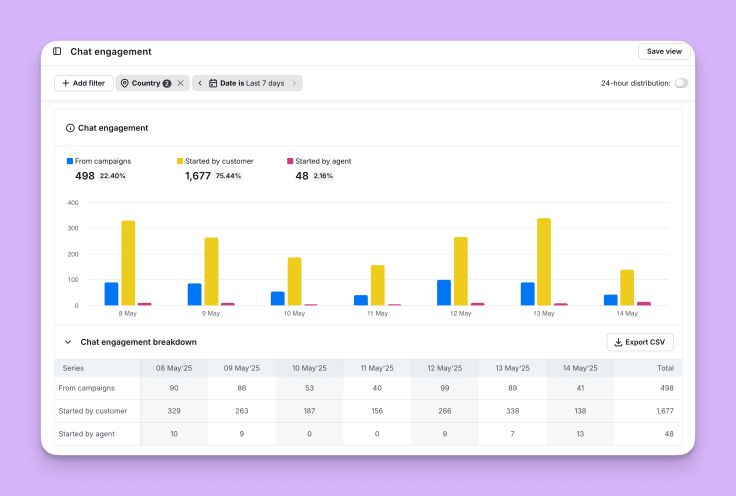
Boost online sales with live chat support
At the heart of every sale is a person, not just a user, a lead, or a conversion, but someone navigating a decision. They might be excited, hesitant, confused, or in a hurry. And in those moments, what they’re really looking for isn’t just a product, it’s clarity, confidence, and connection.
When you use a live chat solution not simply as a tool to answer questions, but as a way to understand the person behind the question, you’re creating something powerful: trust. And trust leads to more than conversions, it leads to loyalty, referrals, and lasting brand advocacy.
Pair that with the right technology, like LiveChat, which blends automation, personalization, and real-time insight, and you don’t just help your customers more effectively. You show them that you’re genuinely there for them.
In the end, the brands that grow fastest are the ones that care the most and know how to show it.

